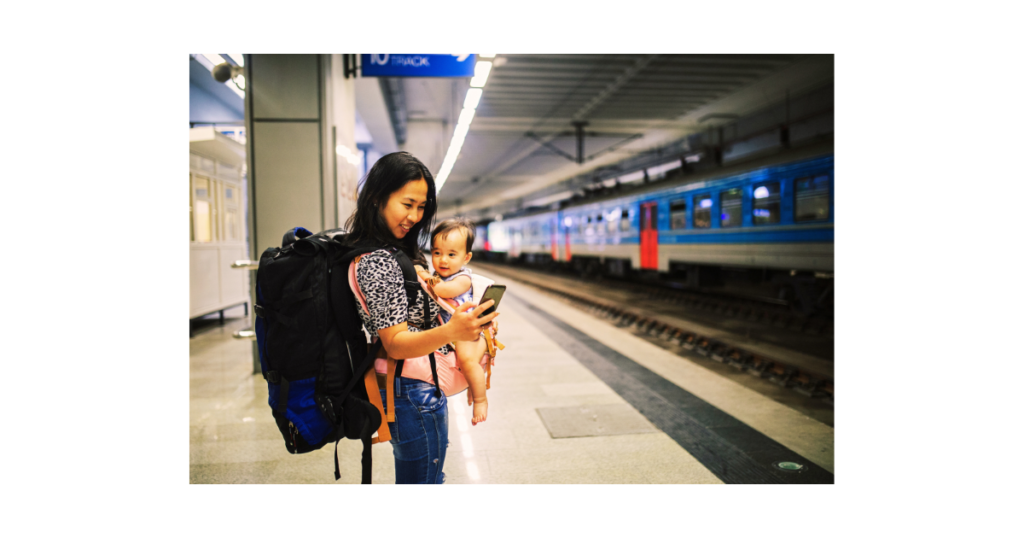Traveling with a baby can feel like an overwhelming adventure. But with the right preparation and mindset, it can turn into a fun and memorable experience for both you and your little one. As a mom who’s navigated airports with a baby carrier strapped on and a diaper bag in tow, I’m here to share everything you need to know for a smoother journey. Let’s dive in!
Preparing for the Trip: How to Travel with an Infant
The secret to a stress-free trip? Planning ahead!
Remember, the key to a smooth journey is preparation and flexibility. Air pressure changes during flights can cause ear pain in babies and toddlers, so consider strategies like having them suck on a bottle or pacifier to help equalize pressure in their ears.
When Can You Travel With a Baby?
Traveling with a newborn can be daunting, but knowing when it’s safe to start can ease your worries. Most pediatricians recommend waiting until your baby is at least 2-3 months old before embarking on a trip. This allows time for their immune system to strengthen, reducing the risk of infections. However, every baby is different, so it’s always best to consult with your pediatrician before making travel plans.
If you need to travel sooner, ensure you have all the necessary supplies, including a well-fitted infant car seat, plenty of baby food, and a well-stocked diaper bag. Remember, the key to a smooth journey is preparation and flexibility.
Choosing the Right Window Seat
When booking your tickets, think about what works best for you and your baby. I personally love a window seat when traveling with my infant because it gives us a bit more privacy. But if you think you’ll need to move around a lot, an aisle seat might be the way to go. If you’re deciding between flying with a lap baby or buying their own seat, remember that having an infant car seat onboard offers extra safety and peace of mind.
Packing Essentials: Diaper Bag
Your diaper bag is your lifesaver—pack it wisely! Here’s what I always include:
- Diapers and wipes
- Changing pad
- Spare clothes for baby (and one for you, just in case)
- Baby food, formula, or breast milk
- Small toys to keep little hands busy
And don’t forget plastic bags for those inevitable soiled clothes or dirty diapers.
Travel Documentation
If you’re flying domestically, most airlines ask for a birth certificate for lap babies. International flights may require a passport and additional documents, so it’s always smart to double-check with the airline directly.
Car Seat Safety and Travel
Traveling with a baby means prioritizing their safety, especially when it comes to car seats. The American Academy of Pediatrics (AAP) advises that babies use a rear-facing car seat until they are at least 2 years old or reach the maximum weight or height limit of their car seat. This position offers the best protection for your little one’s head, neck, and spine in the event of a collision.
Before hitting the road, double-check that your car seat is properly installed and that your baby is securely fastened. A snugly installed rear-facing car seat in the back seat is the safest spot for your infant. Regularly inspect the car seat to ensure it remains secure throughout your journey.
Car Seat Options for Flying
Flying with a baby involves careful planning, especially when it comes to car seats. The Federal Aviation Administration (FAA) allows the use of approved car seats on airplanes, but it’s essential to verify compatibility with your airline. Here are some car seat options to consider:
- Rear-facing car seats: Ideal for babies under 2 years old, these seats provide maximum safety and can be used on airplanes.
- Convertible car seats: These versatile seats can switch between rear-facing and forward-facing positions, making them suitable for babies over 2 years old.
- Infant car seats: Designed for newborns, these seats often require a separate base but can be used on airplanes.
Always check with your airline to ensure your car seat meets their requirements and fits in the airplane seat.
Flying with a Baby
Before the Flight
Take advantage of pre-boarding to get settled in without feeling rushed. Trust me, having that extra time to stow your carry-on, adjust the baby carrier, and set up your space makes a big difference.
Going Through Security with a Baby
Navigating airport security with a baby can be a challenge, but a few tips can make the process smoother:
- Inform the TSA agent: Let the TSA agent know if you have baby food or liquids in your carry-on. These items are subject to additional screening, so it’s best to be upfront.
- Separate baby food and liquids: Place these items in a separate tray to facilitate easier screening.
- Request fresh gloves: If you’re concerned about germs, politely ask the TSA agent to change their gloves before handling your baby’s items.
- Consider checking luggage: To avoid carrying too much through security, consider checking some of your luggage, especially if you have a lot of baby gear.
By following these tips, you can ensure a smoother and less stressful security experience, allowing you to focus on enjoying your trip with your baby.
Onboard Tips
Using a rear-facing car seat or properly installed car seat onboard is the safest option for infants. For takeoff and landing, help ease the pressure on your baby’s ears by offering a bottle, breastfeeding, or using a pacifier to alleviate ear pain.
If your little one manages to nap mid-flight (hooray!), keep them cozy and safe. Sleeping babies are a blessing on a long flight, so pack their favorite blanket or lovey for extra comfort. To ensure baby sleep during flights, consider using airline bassinets, sleeper seats, or inflatable seat extenders.
Managing Meals and Diaper Changes
Feeding Baby: Baby Food
If your baby is still on formula or breast milk, pack plenty. Eating solids? Bring easy-to-pack snacks like pureed pouches or crackers. Remember, the flight crew is usually happy to warm up bottles if you need.
Diaper Changes
Airplane bathrooms aren’t glamorous, but they get the job done. Look for the fold-down changing tables over the closed toilet seat. Always have a changing pad ready and don’t forget plastic bags for cleanup.
Road Trips with an Infant
If you’re hitting the road instead of flying, some strategies will keep everyone sane.
Ensuring Safety
Make sure your rear-facing car seat is snugly installed in the back seat. Check it before every trip to ensure everything is secure.
Keeping Baby Comfortable
Road trips are perfect for flexibility. Take frequent rest stops for feeding, diaper changes, and letting your baby stretch. Pack toys, extra clothes, and their favorite blanket to keep them happy.
Extra Tips for Stress-Free Travel
No matter how much you prepare, things might not go perfectly—and that’s okay!
- Stay calm. Babies pick up on your energy, so keep it positive.
- Pack plenty of diapers, wipes, and snacks. More is always better when traveling.
- If all else fails, bring out desperate measures: the special toy or song they love but you save for emergencies.
Navigating Airline Policies
FAA and Airline Guidelines
The Federal Aviation Administration (FAA) recommends using an FAA-approved car seat during flights for your baby’s safety. Check with your airline about their seatbelt sign policies and whether you can use a lap baby or must bring a car seat onboard.
Airline-Specific Rules
Every airline is different. Some allow gate checks for strollers and car seats, while others have strict rules for lap children and carry-on luggage. Contact the airline directly if you’re unsure.
Final Thoughts
Traveling with an infant isn’t without its challenges, but it’s also incredibly rewarding. Watching your baby discover the world is worth every moment of preparation. Whether it’s their first flight or a long road trip, staying flexible and well-prepared will set you up for success.
What are your favorite travel tips for flying or driving with a baby? Share your thoughts in the comments below, and don’t forget to subscribe for more family travel inspiration and tips!
Additional Resources
For more in-depth tips and guidelines, check out these helpful resources:
- Federal Aviation Administration (FAA) Child Safety Guidelines
- TSA Guidelines for Traveling with Children
- CDC Recommendations for Flying with Babies
- Car Seat Safety Information from Safe Kids Worldwide
- Airline-Specific Policies on Traveling with Infants
These links cover everything from car seat safety to airline-specific policies and health recommendations to make your journey safer and easier.





